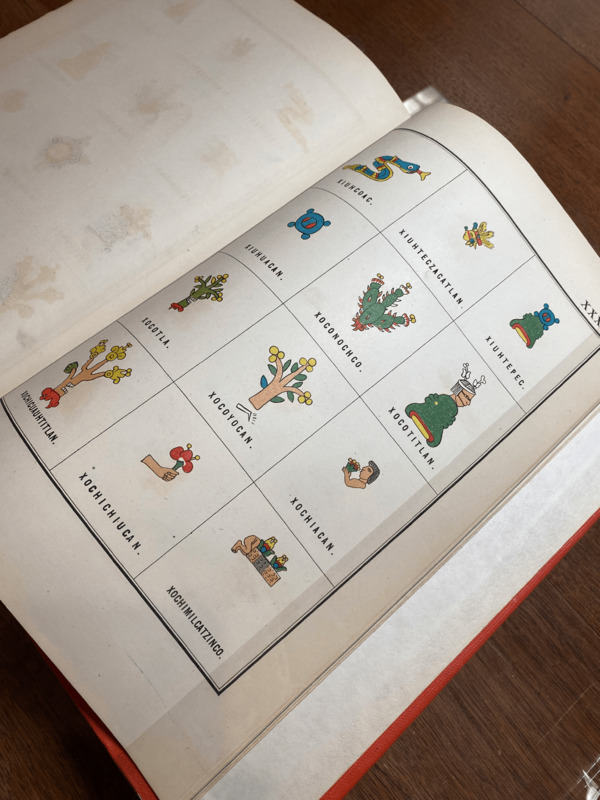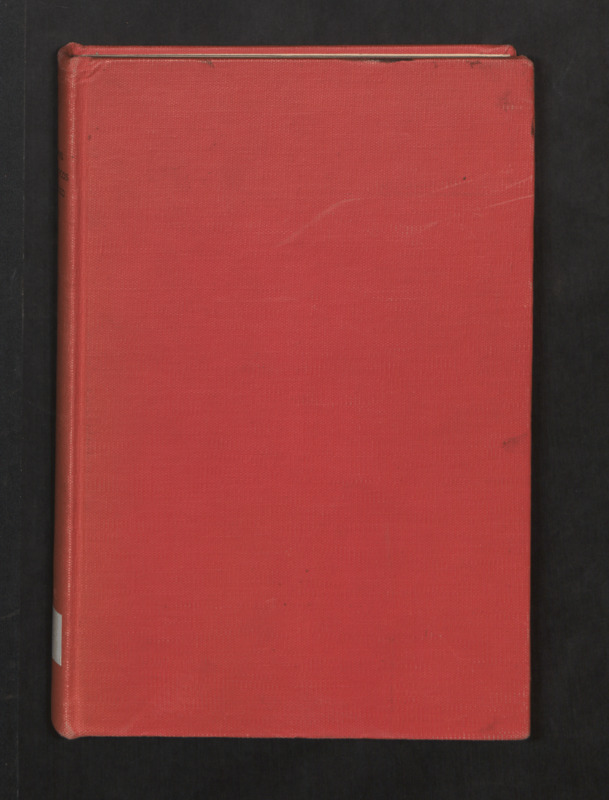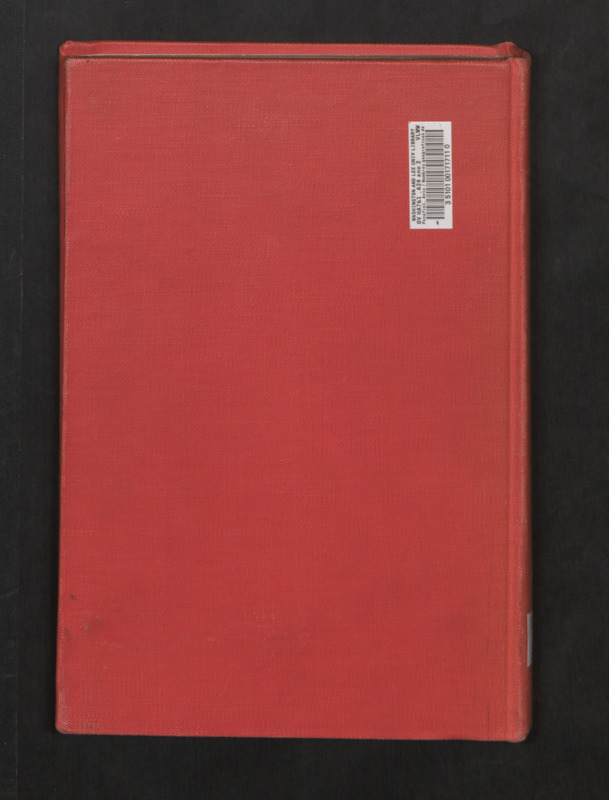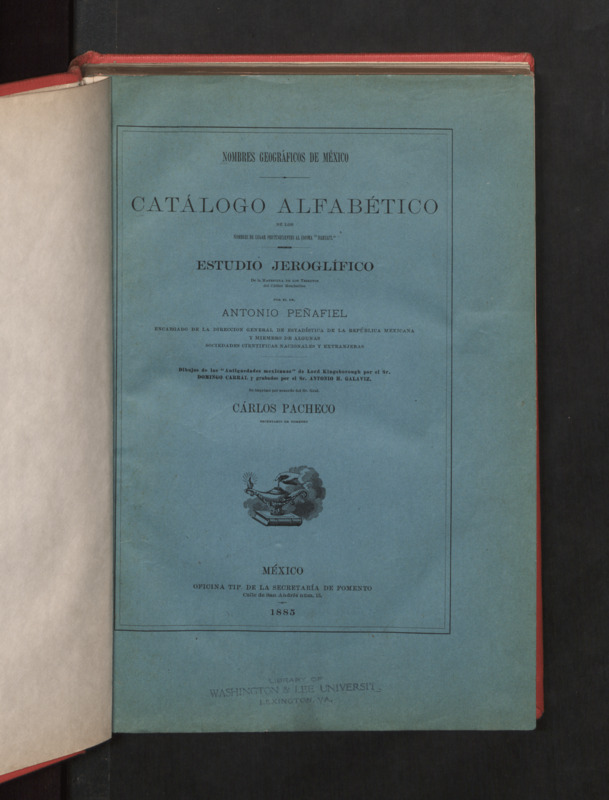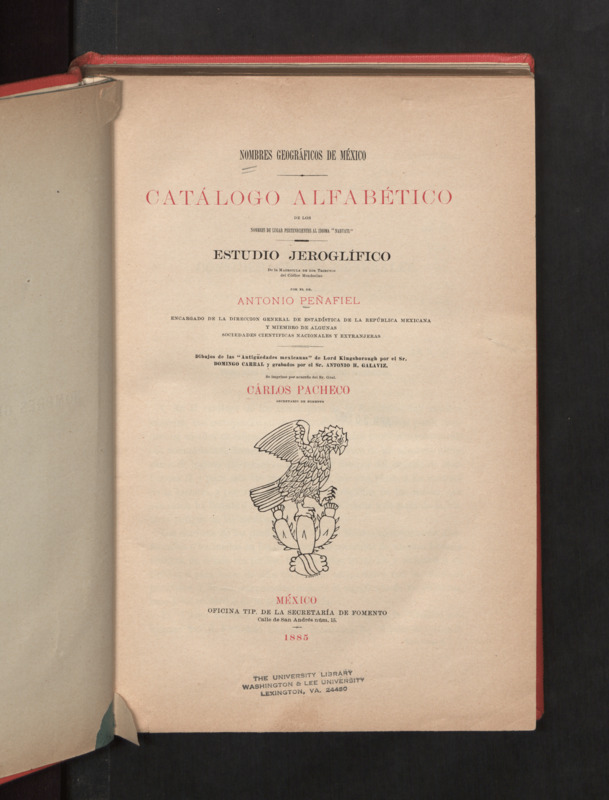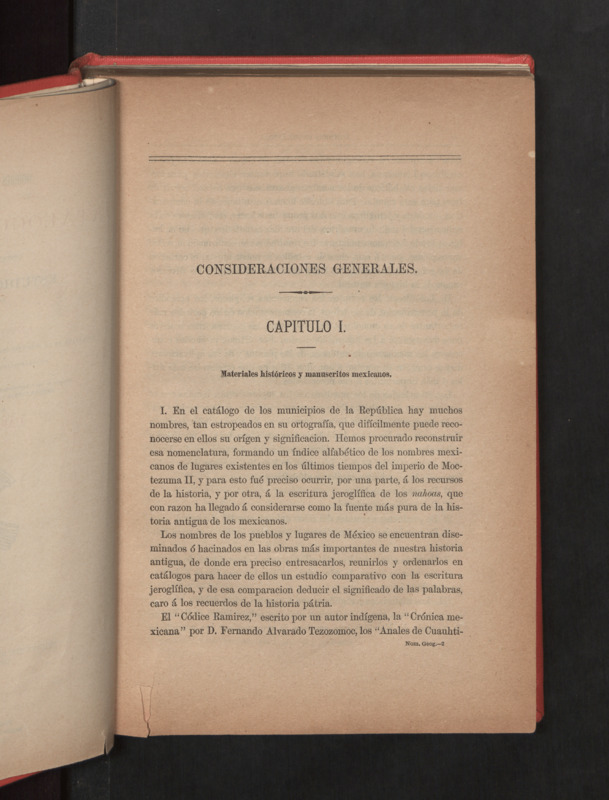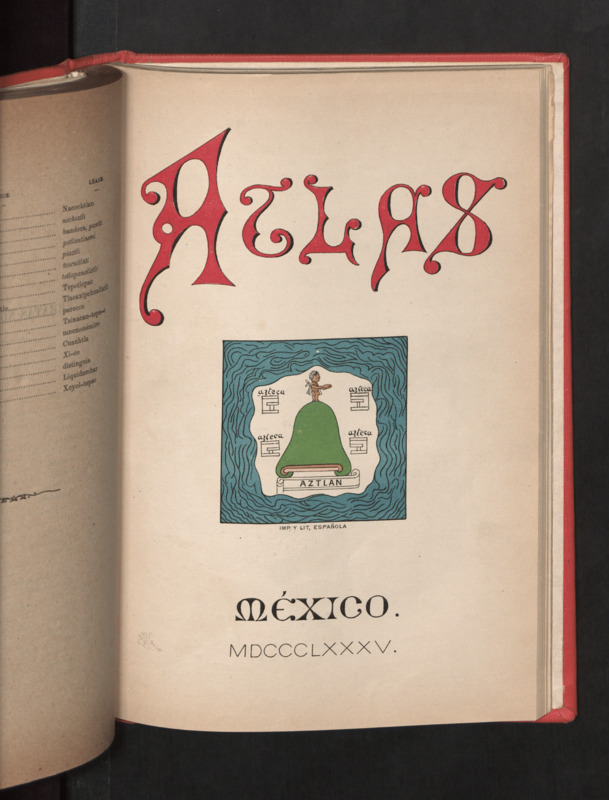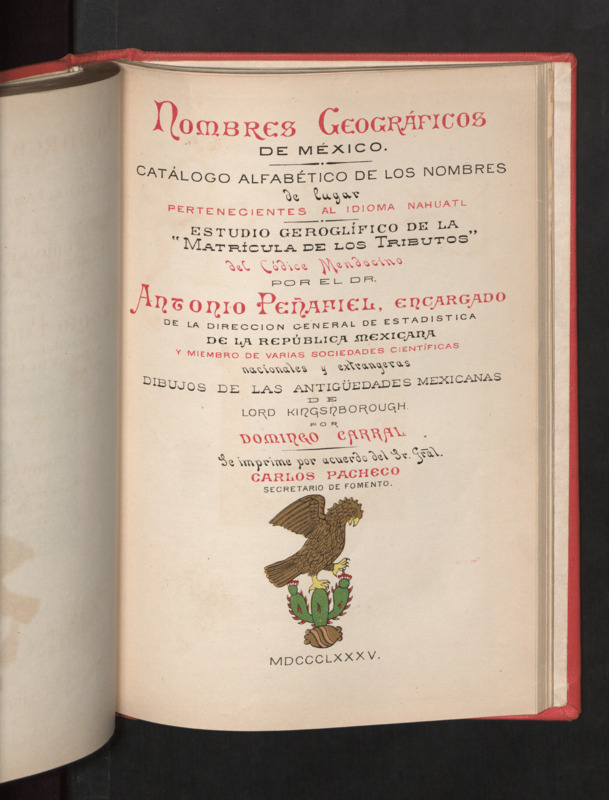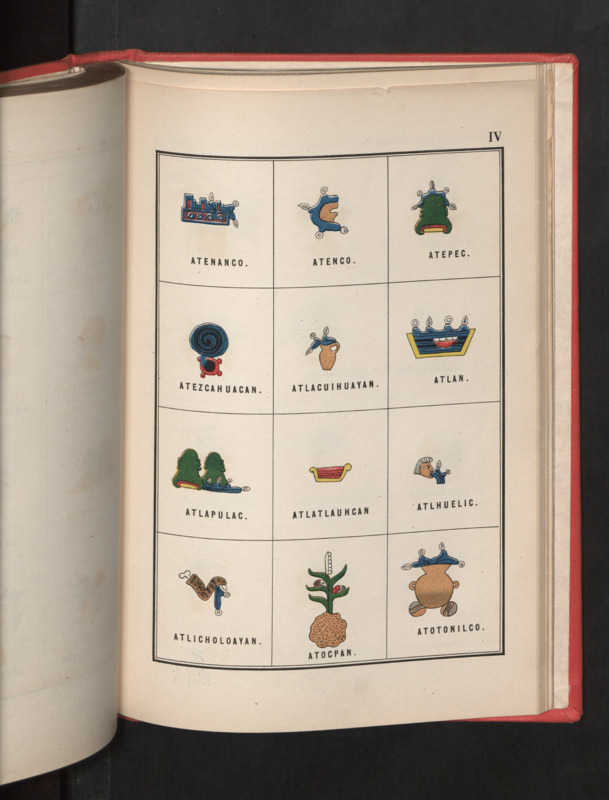Nombres geográficos de México. Catálogo alfabético de los nombres de lugar pertenecientes al idioma náhuatl
Item
-
Title
ES
Nombres geográficos de México. Catálogo alfabético de los nombres de lugar pertenecientes al idioma náhuatl
EN
Geographic Names of Mexico. Alphabetic Catalog of Names Pertaining to the Nahuatl Language
-
Creator
ES
Antonio Peñafiel, editor
EN
Antonio Peñafiel, editor
-
Contributor
ES
Antonio Peñafiel, autor del “Estudio jeroglífico de la ‘matrícula de los tributos’ del Códice Mendocino" | Dibujos por Domingo Carral basados en las imágenes de "Antigüedades de México” hechas por Lord Kingsnborough | Grabados por el Sr. Antonio H. Galaviz
EN
Antonio Peñafiel, author of the “Hieroglyphic Study of the ‘Registration of the Tributes’ of the Codex Mendoza" | Drawings by Domingo Carral based on the images from “Antiquities of Mexico” made by Lord Kingsnborough | Engravings by Mr. Antonio H. Galaviz
-
Description
ES
"Nombres geográficos de México. Catálogo alfabético de los nombres de lugar pertenecientes al idioma náhuatl" por Antonio Peñafiel es un estudio jeroglífico y atlas escrito en 1885. Fue publicado por la Secretaria de Promoción de México, una rama del gobierno dirigida por General Carlos Pacheco. Según la portada, Peñafiel supervisó la dirección de estadísticas de la república mexicana y era erudito en el país y en el extranjero, como miembro de sociedades científicas nacionales y extranjeras. El libro está basado en el Códice Mendocino, que es un códice azteca escrito en 1541 en náhuatl que contiene una historia de ambos gobernantes aztecas y sus exploraciones de México moderno, así como una descripción de la vida cotidiana de la sociedad azteca anterior a su periodo de exploración. En el momento en que se escribió este libro, México prosperó bajo el gobierno de Porfirio Díaz: la infraestructura del país mejoró enormemente, su gobierno se centralizó y estabilizó, su ejército se modernizó y florecieron su seguridad pública, salud pública, ferrocarriles, minería, comercio exterior y finanzas nacionales. El libro está escrito en español y está dirigido a aquellos que hablan este idioma y están interesados en la cultura azteca y el idioma náhuatl. Hoy en día, el náhuatl es una de las lenguas indígenas más habladas de las Américas, con aproximadamente 1.5 millones de hablantes en el centro de México y hablantes en los Estados Unidos. El libro contiene dibujos por Domingo Carral y Antonio Galaviz de jeroglíficos del códice de que hizo un facsímile Lord Kingsnborough en “Antigüedades de México” en 1830. En la sección del libro del estudio jeroglífico, Peñafiel asigna a cada dibujo en blanco y negro su nombre náhuatl y los ordena alfabéticamente. Él define entonces lo que representa cada jeroglífico, explica su origen y explica la etimología de su nombre. Por ejemplo, Peñafiel identifica el primer jeroglífico del libro con el nombre de "Acalhuacán" y lo define como una canoa. Él explica entonces que la canoa tiene "dos manchas negras rectangulares en medio" y que la etimología de la palabra es "el lugar en que hay canoas". Escribe que "can" se refiere a "lugar de", "hua" se refiere al "posesivo de la anterior" y "acalli" se refiere a la canoa (pag. 39). Al final del libro en el atlas, Peñafiel incluye jeroglíficos del códice en color. Los colores son vibrantes y visualmente atractivos. Debajo de cada jeroglífico, él incluye su nombre náhuatl. Por ejemplo, en la página XIX, Peñafiel asigna a un jeroglífico de un cactus verde y rojo el nombre de "nopalla".
EN
“Geographic Names of Mexico. Alphabetic Catalog of Names Pertaining to the Nahuatl Language” by Antonio Peñafiel is a hieroglyphic study and atlas written in 1885. It was published by Mexico’s Secretary of Promotion, a branch of government led by General Carlos Pacheco. According to the title page, Peñafiel oversaw the Mexican republic’s direction of statistics and was a figure with authority at home and abroad, as a member of national and foreign scientific societies. The book is based on the Codex Mendoza, which is an Aztec codex written in 1541 in Nahuatl that contains a history of Aztec rulers and their exploration of modern-day Mexico, as well as a description of the daily life of Aztec society before their period of exploration. At the time this book was written, Mexico prospered under the rule of Porfirio Díaz: the country's infrastructure greatly improved, its government centralized and stabilized, its army modernized, and its public safety, public health, railways, mining, foreign trade, and national finances flourished. The book is written in Spanish and is targeted towards those who speak this language and are interested in Aztec culture and the Nahuatl language. Today, Nahuatl is one of the most widely spoken indigenous languages of the Americas, with approximately 1.5 million speakers in central Mexico and speakers in the United States. The book contains drawings by Domingo Carral and Antonio Galaviz of hieroglyphics from the codex that were facsimiled by Lord Kingsnborough in “Antiquities of Mexico” in 1830. In the hieroglyphic study section of the book, Peñafiel assigns each black-and-white drawing its Nahuatl name and orders them alphabetically. He then defines what each hieroglyphic represents, explains their origin, and explains their name’s etymology. For example, Peñafiel identifies the first hieroglyphic in the book with the name “Acalhuacan” and defines it as a canoe. He then explains that the canoe has “two black rectangular marks in the middle” and that the etymology of the word is “the place in which there are canoes.” Peñafiel writes that “can” refers to “place of,” “hua” refers to the “possessive of the anterior,” and “acalli” refers to the canoe (p. 39). At the end of the book in the atlas, he includes hieroglyphics from the codex in color. The colors are vibrant and visually appealing. Under each hieroglyphic, Peñafiel includes its Nahuatl name. For example, on page XIX, he assigns a hieroglyphic of a green and red cactus the name “nopalla.”
-
Publisher
ES
Oficina Típica de la Secretaría de Fomento
EN
Traditional Office of the Secretary of Promotion
-
Extent
ES
253 páginas seguidas por un atlas de 39 páginas
EN
253 pages followed by an atlas of 39 pages
-
Language
ES
El español, náhuatl
EN
Spanish, Nahuatl
-
Format
ES
largo: ~12” | ancho: ~8" | grosor: ~1”
EN
length: ~12” | width: ~8” | thickness: ~1”
-
Rights
ES
Este material se ha hecho disponible para uso en investigaciónes, tanto académicas como privadas, y en la docencia, de conformidad con la ley de derechos de autor de EE. UU. El usuario asume toda la responsabilidad por cualquier uso de los materiales, incluida, entre otras, la infracción de los derechos de autor y los derechos de publicación de los materiales reproducidos. La fuente de cualquier material utilizado debe acreditarse claramente. El permiso para la publicación de este material, en parte o en su totalidad, debe obtenerse de el/la/le Jefe de las Colecciones Especiales de WLU.
EN
This material is made available for use in research, teaching, and private study, pursuant to U.S. Copyright law. The user assumes full responsibility for any use of the materials, including but not limited to, infringement of copyright and publication rights of reproduced materials. Any materials used should be fully credited with the source. Permission for publication of this material, in part or in full, must be secured with the Head of Special Collections.
-
Subject
ES
Idioma náhuatl | Indígenas de México – idiomas | Jeroglíficos aztecas | Topónimos
EN
Nahuatl language | Indigenous peoples of Mexico – languages | Aztec hieroglyphics | Toponyms
-
Illustrative content information
ES
Portada: imágen de una áquila y un nopal | Estudio jeroglífico: dibujos en blanco y negro | Atlas: jeroglíficos en color
EN
Title page: image of an eagle and a cactus | Hieroglyphic study: black and white drawings | Atlas: hieroglyphics in color
-
Secondary Features
ES
Originalmente, en rústica; ahora, de tapa dura | Reencuadernado con bucarán en 1954 | Estampa de la biblioteca de W&L indicando la fecha de adquisición (20 de abril 1982) | Solo un ex libris de la Universidad de Washington and Lee
EN
Originally paperback, now hardcover | Rebound with buckram in 1954 | Stamp of the W&L Library indicating the date of acquisition (April 20, 1982) | Only one bookplate from Washington and Lee University
-
Genre/form
ES
Atlas jeroglífico | Diccionario toponímico
EN
Hieroglyphic atlas | Toponymic dictionary
-
Book format
ES
Tapa dura
EN
Hardcover
